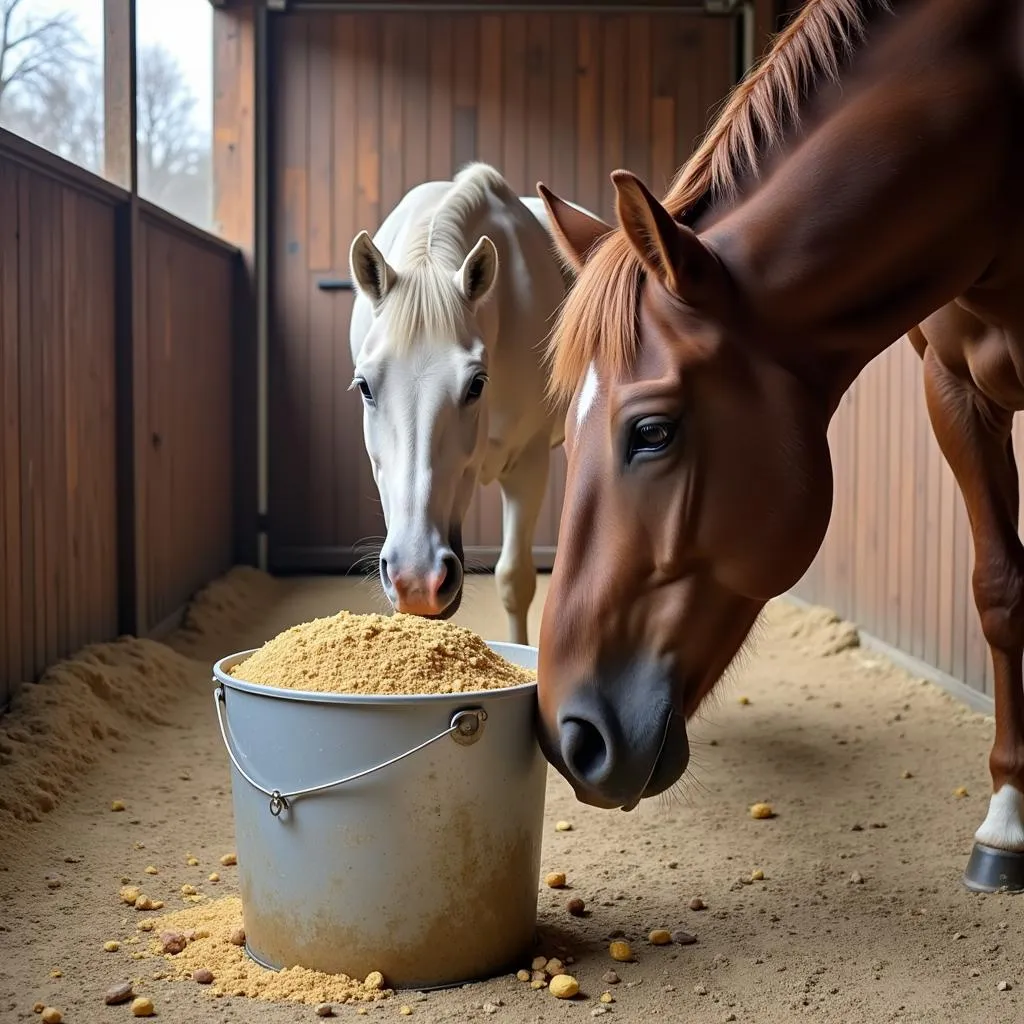Diatomaceous earth (DE) is a popular natural supplement for horses, often praised for its ability to control internal parasites and improve coat condition. But with so much information available, it can be challenging to separate fact from fiction. This comprehensive guide delves into the benefits, uses, and potential risks of using diatomaceous earth for horses, providing you with the knowledge to make informed decisions for your equine companion.
What is Diatomaceous Earth?
Diatomaceous earth is a fine, white powder made from the fossilized remains of diatoms, tiny aquatic organisms with silica skeletons. When diatoms die, their skeletons accumulate in sediment layers, forming DE deposits.
There are two main types of DE:
- Food Grade Diatomaceous Earth: This type is safe for humans and animals and is the only type suitable for horses. It undergoes rigorous processing to remove impurities and ensure a low crystalline silica content.
- Pool Grade Diatomaceous Earth: This type is used in swimming pool filtration systems and is highly toxic if ingested. Never use pool-grade DE on or around your horses.
How Does Diatomaceous Earth Work?
Food grade DE works mechanically, not chemically. The microscopic, sharp edges of the diatom skeletons act like tiny blades, damaging the exoskeletons of insects and parasites upon contact. This damage disrupts their waxy coating, leading to dehydration and death.
Benefits of Diatomaceous Earth for Horses
 Horse with shiny coat
Horse with shiny coat
Horse owners use DE for a variety of reasons, including:
1. Internal Parasite Control
DE is often touted as a natural dewormer for horses. While it can help control certain internal parasites, it’s crucial to understand its limitations. DE is most effective against parasites with an exoskeleton, such as:
- Roundworms: These common equine parasites can cause weight loss, colic, and poor performance.
- Pinworms: These parasites irritate the skin around a horse’s anus, leading to tail rubbing.
- Bots: These fly larvae attach to a horse’s stomach lining and can cause digestive upset.
However, DE is less effective against parasites without an exoskeleton, such as tapeworms.
2. External Parasite Control
DE can be used topically to repel and kill external parasites like:
- Flies: Sprinkle DE around your horse’s stall, manure pile, and other fly-prone areas to deter these pesky insects.
- Ticks: DE can help control ticks in your horse’s environment, but it’s essential to use a tick prevention product directly on your horse for optimal protection.
- Mites and Lice: DE can be applied to your horse’s coat to kill these tiny parasites that cause itching and hair loss.
For more information on using DE for fly control in horses, check out our article on diatomaceous earth fly control horses.
3. Improved Coat Condition
 Horse eating feed with diatomaceous earth
Horse eating feed with diatomaceous earth
Some horse owners believe that DE’s silica content can improve coat health and shine. While research on this specific benefit is limited, silica is a crucial component of healthy skin, hair, and hooves.
4. Digestive Health
Proponents of DE suggest that it can promote a healthy digestive tract by absorbing toxins and supporting beneficial gut bacteria. However, scientific evidence to support these claims is lacking.
How to Use Diatomaceous Earth for Horses
Always consult your veterinarian before adding DE to your horse’s diet or using it topically. They can help determine the appropriate dosage and application method based on your horse’s individual needs.
Internal Use
- Dosage: The recommended dosage of DE for horses varies depending on the horse’s weight and the reason for use. A general guideline is 1/2 to 2 cups per day, mixed thoroughly into your horse’s feed.
- Frequency: For parasite control, DE is typically given daily for a specific period, followed by a break. Your veterinarian can advise you on the appropriate schedule.
External Use
- Application: When applying DE topically, wear a dust mask to avoid inhalation. Sprinkle a fine layer of DE on your horse’s coat, avoiding the eyes and nostrils. You can also use a duster or a sock filled with DE for a more even application.
- Frequency: For external parasite control, apply DE as needed, but avoid excessive use, as it can dry out your horse’s skin.
Potential Risks and Side Effects
While generally considered safe, DE can pose some risks if not used correctly:
- Respiratory Irritation: Inhaling DE dust can irritate the respiratory tract of both horses and humans. Always wear a dust mask when handling DE, and wet the powder slightly before applying it to your horse to minimize dust.
- Eye Irritation: Avoid getting DE in your horse’s eyes, as it can cause irritation. If contact occurs, flush the eyes with plenty of water.
- Skin Dryness: Excessive topical use of DE can dry out your horse’s skin.
Diatomaceous Earth: Not a Standalone Solution
 Veterinarian examining a horse
Veterinarian examining a horse
While DE can be a beneficial addition to your horse care toolkit, it’s essential to remember that it’s not a cure-all or a replacement for conventional veterinary care.
- Regular deworming: DE should not replace regular deworming protocols recommended by your veterinarian. Fecal egg count tests can help determine the type and load of parasites present, guiding your deworming strategy.
- Veterinary Consultations: Always consult your veterinarian if you suspect your horse has a parasite infestation or other health concerns.
Conclusion
Diatomaceous earth offers a natural approach to managing internal and external parasites in horses, and its potential benefits for coat and digestive health make it an attractive option for many horse owners. However, responsible use requires understanding its limitations, potential risks, and the importance of ongoing veterinary care. By working closely with your veterinarian and following recommended guidelines, you can safely incorporate DE into your horse’s care regimen, contributing to their overall health and well-being.
FAQs
1. Can I give my pregnant mare diatomaceous earth?
It’s best to consult your veterinarian before giving DE to a pregnant mare. They can advise you on the safety and potential risks based on your mare’s individual circumstances.
2. How long does it take for diatomaceous earth to work?
DE works mechanically upon contact with parasites, so you may see results within a few days to a week. However, it’s important to note that DE is not a quick fix, and regular use, along with other parasite control measures, is crucial.
3. Where can I buy food-grade diatomaceous earth?
You can find food-grade DE at feed stores, farm supply stores, and online retailers. Make sure to purchase a product specifically labeled as “food grade” and safe for horses.
4. Can I use diatomaceous earth on other animals?
Yes, food-grade DE is generally safe for use on other animals, including dogs, cats, and poultry. However, it’s essential to adjust the dosage and application method accordingly.
5. What should I do if my horse accidentally inhales a large amount of DE?
If your horse inhales a significant amount of DE, remove them from the area immediately and provide fresh air. Contact your veterinarian as a precaution, as they can assess your horse for respiratory irritation and provide appropriate treatment if needed.
Need more help? Contact us at Phone Number: 0772127271, Email: [email protected] Or visit us at QGM2+WX2, Vị Trung, Vị Thuỷ, Hậu Giang, Việt Nam. We have a 24/7 customer service team.